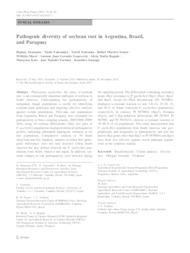Pathogenic diversity of soybean rust in Argentina, Brazil, and Paraguay.
Pathogenic diversity of soybean rust in Argentina, Brazil, and Paraguay.
Author(s): AKAMATSU, H.; YAMANAKA, N.; YAMAOKA, Y.; SOARES, R. M.; MOREL, W.; IVANCOVICH, A. J. G.; BOGADO, A. N.; KATO, M.; YORINORI, J. T.; SUENAGA, K.
Summary: Phakopsora pachyrhizi, the cause of soybean rust, is an economically important pathogen of soybean in South America. Understanding the pathogenicity of indigenous fungal populations is useful for identifying resistant plant genotypes and targeting effective cultivars against certain populations. Fifty-nine rust populations from Argentina, Brazil, and Paraguay were evaluated for pathogenicity in three cropping seasons, 2007/2008?2009/2010, using 16 soybean differentials. Only two pairs of P. pachyrhizi populations displayed identical pathogenicity profiles, indicating substantial pathogenic variation in the rust populations. Comparative analysis of 59 South American and five Japanese samples revealed that pathogenic differences were not only detected within South America but also distinct between the P. pachyrhizi populations from South America and Japan. In addition, seasonal changes in rust pathogenicity were detected during the sampling period. The differentials containing resistance genes (Rpp: resistance to P. p achyrhizi) Rpp1, Rpp2, Rpp3, and Rpp4, except for Plant Introduction (PI) 587880A, displayed a resistant reaction to only 1.8?14, 24?28, 22, and 36 % of South American P. pachyrhizi populations, respectively. In contrast, PI 587880A (Rpp1), Shiranui (Rpp5), and 3 Rpp-unknown differentials (PI 587855, PI 587905, and PI 594767A) showed a resistant reaction to 78?96 % of all populations. This study demonstrated that P. pachyrhizi populations from South America vary geographically and temporally in pathogenicity and that the known Rpp genes other than Rpp1 in PI 587880A and Rpp5 have been less effective against recent pathogen populations in the countries studied.
Publication year: 2013
Types of publication: Journal article
Unit: Embrapa Soybean
Keywords: Soja
Observation
Some of Embrapa's publications are published as ePub files. To read them, use or download one of the following free software options to your computer or mobile device. Android: Google Play Books; IOS: iBooks; Windows and Linux: Calibre.
Access other publications
Access the Agricultural Research Database (BDPA) to consult Embrapa's full library collection and records.
Visit Embrapa Bookstore to purchase books and other publications sold by Embrapa.

